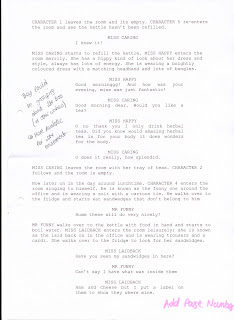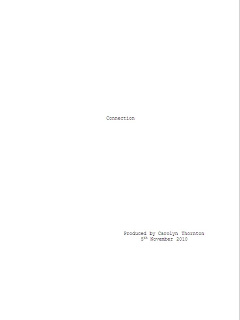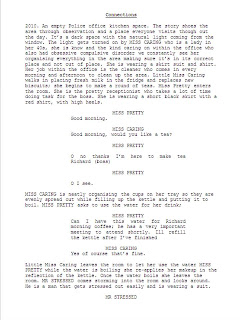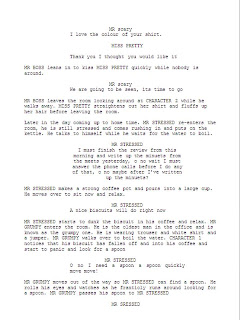A quote by broadwell and Thompson states “Lighting can be characterised by its source. In making a documentary, the filmmaker may be obliged to shoot with the light available in the actual surroundings. Most fictional films, however, use extra light sources to obtain greater control of the images look. In most fictional films, the table lamp and street light you see in the mise-en-scene are not the principle source of illumination for the filming.” From this quote its clear that filmmaker may be limited in what sources of light they can use and what is available to them, for example, if they are filming in an already built location that is used in everyday not just in their film, then they have no option than to just use the light sources they have available such as windows and ceiling lights. In addition this also applied to our productions, as we don’t have the money to be buying and using light worth hundreds of pounds we are forced to use the light available however can use additional lighting to add different effects and colours.
This picture from Harry Potter shows the addition lighting they have added into this scene. From the mise-en-scene and from the audience point of view the light source is meant to be coming from the old style street lamps however this would not illuminate the characters enough and would cause a lot of shadow. This had lead them to add and overhead light to illuminate the two characters faces and clothing.
As a class we then look at two images from Forest Gump. The first of the photos had a lot of real natural lighting as well as using soft lights to create this look. We noticed that they’re a small amount off attached shadows on their clothes, which was created by the soft lighting, which reduces the difference between the light and dark areas. In the second image it was the complete opposite that used hard lighting, which made it, look very artificial. It was also a hard quality which created a bleached effected on the clothes meaning we where unable to see and attached shadows.
When then looked at another two images at how lighting can be used to create different atmospheres. The first image was of a bear corridor; the filmmaker would have no control over the light sources as they are already in place. The lights are at the highest point possible illuminating the whole corridor. The hard bright light creates reflections of the walls and floor. The second image we looked at was taken from a film and had a much more interesting atmosphere from the audience point of view. The light sources they have used create shadows below the lights themselves pointing the light upwards. There is also ceiling lights hidden by the piece of wood pointing down so we can see the middle of the corridor, there is also an additional light source coming from in front of the character to illuminate the mans face.
In class we then went onto looking at the different areas of the mise-en-scene and how its just as important to think about the light sources there as well as the location.
When we look at any lighting in film we normally associate it this with two different lights, such as the key light and the fill light. The key light is used to provide the dominant illumination and normally casts the strongest shadows. The fill light is used to provide the less intense illumination, which ‘fills in’ and softens the shadows. This is linked to research that I carried out last year for our opening sequences where I looked at 3 point lighting. In classical Hollywood film making developed the custom of using three-point lighting. However, this needs to be used with care as lights may need to be moved depending on the position of the camera but continuity of lighting must be maintained.
As a class we where then spilt into group and asked to look further into effect of lighting and how it can be used to create an atmosphere, relating back to the photos we was looking at earlier in the lesson. We were all given a different school corridor and we were asked to shot two different scenes. The first was using the light that was available to use such as ceiling lights or natural lights and then for our second scene we had to find a way of manipulating the light to change the atmosphere of the shot. Our video is shown below.
Our first shot we was using the light sources that were available to use, this was the natural lighting coming from the windows and the ceiling lights. For our next shot however, we used off the ceiling lights and turned on the spotlights in the ceiling we moved the lights so they were facing down on my face. This had a massive effect on the atmosphere it no longer felt and looked like a school corridor and could be any location. This was very successful and we were very pleased over all. However, we was unable to block out all off the natural light coming which lead to a mixture of artificial light and natural light which doesn’t come across very nicely on film. If we were to do this task again I think we would try harder to block out the natural light so we was only left with the artificial light.
One example would be your shooting a scene that has daylight entering through a large window with tungsten light sources inside. As a director you need to experiment different ways in which you can achieve a nice look so that the daylight outside wont look washed out or look to white. One way of over coming this would be to add red gels over the windows to turn the day light into tungsten light, however, this is very time consuming and requires a highly skilled team. A much cheaper and quicker way would be to add blue gels over the light sources inside to match the daylight from outside.
An example of this was done by another group in our class who added blue gels to their light source to the make the artificial light look like natural day light.
After looking at the different kind of gel to make the colour temperatures add up, we then looked at how to add warmth into a image. There are two different ways you can do this, the first, is to have a video colourist fix in the post production stages. However, this is expensive and very time consuming. The second way would be to add a red 85 onto the camera this will make all the light sources match the daylight. Another way you can do this is to add a white balance to a light blue card this tricks the camera into thinking the light blue is white. All these techniques will produce warmer tones on the image.
This is an example of the use of an 85 red lens being added to the camera, we can see that the second image Is much warmer and is over all much nicer to look at. When we are shooting our own shot films we need to remember all these different techniques. We need to plan and think carefully about what kind of atmosphere we want to create and how different light sources and colours will have and effect on the over all image.
After looking at the different kind of gel to make the colour temperatures add up, we then looked at how to add warmth into a image. There are two different ways you can do this, the first, is to have a video colourist fix in the post production stages. However, this is expensive and very time consuming. The second way would be to add a red 85 onto the camera this will make all the light sources match the daylight. Another way you can do this is to add a white balance to a light blue card this tricks the camera into thinking the light blue is white. All these techniques will produce warmer tones on the image.
This is an example of the use of an 85 red lens being added to the camera, we can see that the second image Is much warmer and is over all much nicer to look at. When we are shooting our own shot films we need to remember all these different techniques. We need to plan and think carefully about what kind of atmosphere we want to create and how different light sources and colours will have and effect on the over all image.


































